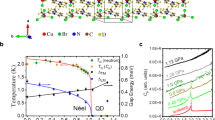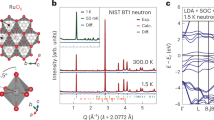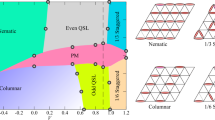Abstract
A quantum critical point (QCP) is a singularity in the phase diagram arising because of quantum mechanical fluctuations. The exotic properties of some of the most enigmatic physical systems, including unconventional metals and superconductors, quantum magnets and ultracold atomic condensates, have been related to the importance of critical quantum and thermal fluctuations near such a point. However, direct and continuous control of these fluctuations has been difficult to realize, and complete thermodynamic and spectroscopic information is required to disentangle the effects of quantum and classical physics around a QCP. Here we achieve this control in a high-pressure, high-resolution neutron scattering experiment on the quantum dimer material TlCuCl3. By measuring the magnetic excitation spectrum across the entire quantum critical phase diagram, we illustrate the similarities between quantum and thermal melting of magnetic order. We prove the critical nature of the unconventional longitudinal (Higgs) mode of the ordered phase by damping it thermally. We demonstrate the development of two types of criticality, quantum and classical, and use their static and dynamic scaling properties to conclude that quantum and thermal fluctuations can behave largely independently near a QCP.
This is a preview of subscription content, access via your institution
Access options
Subscribe to this journal
Receive 12 print issues and online access
$209.00 per year
only $17.42 per issue
Buy this article
- Purchase on Springer Link
- Instant access to full article PDF
Prices may be subject to local taxes which are calculated during checkout




Similar content being viewed by others
Change history
09 April 2014
In the version of this Article originally published online, in Fig. 2b the data points, the purple shaded region, the green dashed curve and a part of the solid black curve were missing. This has now been corrected in all versions of the Article.
References
Goldstone, J., Salam, A. & Weinberg, S. Broken symmetries. Phys. Rev. 127, 965–970 (1962).
Chakravarty, S., Halperin, B. I. & Nelson, D. R. Two-dimensional quantum Heisenberg antiferromagnet at low temperatures. Phys. Rev. B 39, 2344–2371 (1989).
Sachdev, S. Quantum Phase Transitions (Cambridge Univ. Press, 2011).
von Löhneysen, H., Rosch, A., Vojta, M. & Wölfle, P. Fermi-liquid instabilities at magnetic quantum phase transitions. Rev. Mod. Phys. 79, 1015–1075 (2007).
Knafo, W., Raymond, S., Lejay, P. & Flouquet, J. Antiferromagnetic criticality at a heavy-fermion quantum phase transition. Nature Phys. 5, 753–757 (2009).
Stockert, O. et al. Magnetically driven superconductivity in CeCu2Si2 . Nature Phys. 7, 119–124 (2011).
Bourbonnais, C. & Jérome, D. in The Physics of Organic Superconductors and Conductors (ed. Lebed, A.) (Springer, 2008).
Kanoda, K. & Kato, R. Mott physics in organic conductors with triangular lattices. Annu. Rev. Condens. Matter Phys. 2, 167–188 (2011).
Bloch, I., Dalibard, J. & Zwerger, W. Many-body physics with ultracold gases. Rev. Mod. Phys. 80, 885–964 (2008).
Zhang, X-B., Hung, C-L., Tung, S-K. & Chin, C. Observation of quantum criticality with ultracold atoms in optical lattices. Science 335, 1070–1072 (2012).
Nikuni, T., Oshikawa, M., Oosawa, A. & Tanaka, H. Bose–Einstein condensation of dilute magnons in TlCuCl3 . Phys. Rev. Lett. 84, 5868–5871 (2000).
Giamarchi, T., Rüegg, Ch. & Tchernyshyov, O. Bose–Einstein condensation in magnetic insulators. Nature Phys. 4, 198–204 (2008).
Tanaka, H., Goto, K., Fujisawa, M., Ono, T. & Uwatoko, Y. Magnetic ordering under high pressure in the quantum spin system TlCuCl3 . Physica B 329–333, 697–698 (2003).
Rüegg, Ch. et al. Pressure-induced quantum phase transition in the spin-liquid TlCuCl3 . Phys. Rev. Lett. 93, 257201 (2004).
Matsumoto, M., Normand, B., Rice, T. M. & Sigrist, M. Field- and pressure-induced magnetic quantum phase transitions in TlCuCl3 . Phys. Rev. B 69, 054423 (2004).
Jin, S. & Sandvik, A. W. Universal Néel temperature in three-dimensional quantum antiferromagnets. Phys. Rev. B 85, 020409(R) (2012).
Affleck, I. & Wellman, G. F. Longitudinal modes in quasi-one-dimensional antiferromagnets. Phys. Rev. B 46, 8934–8953 (1992).
Lake, B., Tennant, D. A. & Nagler, S. E. Novel longitudinal mode in the coupled quantum chain compound KCuF3 . Phys. Rev. Lett. 85, 832–835 (2000).
Rüegg, Ch. et al. Quantum magnets under pressure: Controlling elementary excitations in TlCuCl3 . Phys. Rev. Lett. 100, 205701 (2008).
Oitmaa, J., Kulik, Y. & Sushkov, O. P. Universal finite-temperature properties of a three-dimensional quantum antiferromagnet in the vicinity of a quantum critical point. Phys. Rev. B 85, 144431 (2012).
Podolsky, D., Auerbach, A. & Arovas, D. P. Visibility of the amplitude (Higgs) mode in condensed matter. Phys. Rev. B 84, 174522 (2011).
Rüegg, Ch. et al. Quantum statistics of interacting dimer spin systems. Phys. Rev. Lett. 95, 267201 (2005).
Normand, B. & Rüegg, Ch. Complete bond-operator theory of the two-chain spin ladder. Phys. Rev. B 83, 054415 (2011).
Shevchenko, P. V., Sandvik, A. W. & Sushkov, O. P. Double-layer Heisenberg antiferromagnet at finite temperature: Brueckner Theory and quantum Monte Carlo simulations. Phys. Rev. B 61, 3475–3487 (2000).
Oosawa, A. et al. Pressure-induced successive magnetic phase transitions in the spin gap system TlCuCl3 . J. Phys. Soc. Jpn 73, 1446–1449 (2004).
Sachdev, S. Quantum Theory of Condensed Matter, presented at 24th Solvay Conference on Physics. Brussels, Oct 2008. Preprint at http://arxiv.org/abs/0901.4103 (2009)
Zinn-Justin, J. Quantum Field Theory and Critical Phenomena (Oxford Univ. Press, (2002).
Podolsky, D. S. & Sachdev, S. Spectral functions of the Higgs mode near two-dimensional quantum critical points. Phys. Rev. B 86, 054508 (2012).
Greif, D., Uehlinger, T., Jotzu, G., Tarruell, L. & Esslinger, T. Short-range quantum magnetism of ultracold fermions in an optical lattice. Science 340, 1307–1310 (2013).
Kulik, Y. & Sushkov, O. P. Width of the longitudinal magnon in the vicinity of the O(3) quantum critical point. Phys. Rev. B 84, 134418 (2012).
Littlewood, P. B. & Varma, C. M. Gauge-invariant theory of the dynamical interaction of charge density waves and superconductivity. Phys. Rev. Lett. 47, 811–814 (1981).
Endres, M. et al. The ‘Higgs’ amplitude mode at the two-dimensional superfluid/Mott insulator transition. Nature 487, 454–458 (2012).
Talbot, E. F., Glyde, H. R., Stirling, W. G. & Svensson, E. C. Temperature dependence of S(Q, ω) in liquid 4He under pressure. Phys. Rev. B 38, 11229–11244 (1988).
Fåk, B. & Dorner, B. Phonon line shapes and excitation energies. Physica B 234–236, 1107–1108 (1997).
Acknowledgements
We are grateful to S. Sachdev, A. Sandvik and especially M. Vojta for helpful comments. We thank the sample environment team at the Institut Laue Langevin, where these measurements were performed, for their assistance. This work was supported by the EPSRC, the Royal Society, the Swiss NSF, and the NSF of China under Grant No. 11174365.
Author information
Authors and Affiliations
Contributions
P.M. and Ch.R. carried out the experiments with the help of instrument scientist M.B. TlCuCl3 single crystals were synthesized by K.W.K. The theoretical and experimental framework was conceived by Ch.R., D.F.M. and B.N. Data refinement and figure preparation were performed by P.M. and Ch.R. The text was written by B.N. and Ch.R.
Corresponding author
Ethics declarations
Competing interests
The authors declare no competing financial interests.
Rights and permissions
About this article
Cite this article
Merchant, P., Normand, B., Krämer, K. et al. Quantum and classical criticality in a dimerized quantum antiferromagnet. Nature Phys 10, 373–379 (2014). https://doi.org/10.1038/nphys2902
Received:
Accepted:
Published:
Issue Date:
DOI: https://doi.org/10.1038/nphys2902
This article is cited by
-
Field-controlled multicritical behavior and emergent universality in fully frustrated quantum magnets
npj Quantum Materials (2024)
-
Field control of quasiparticle decay in a quantum antiferromagnet
Nature Communications (2024)
-
Evidence for pressure induced unconventional quantum criticality in the coupled spin ladder antiferromagnet C9H18N2CuBr4
Nature Communications (2022)
-
Continuous control of classical-quantum crossover by external high pressure in the coupled chain compound CsCuCl3
Nature Communications (2021)
-
A quantum magnetic analogue to the critical point of water
Nature (2021)



